Abstract
Reusing dredged sediments as cement-stabilized fill material offers a sustainable solution for high-fill construction projects, particularly in regions with limited land resources and strict environmental regulations. Nonetheless, the curing pressure from their weight heavily affects these materials’ mechanical properties. This research examines the impact of high curing pressure on the stress–strain behavior, unconfined compressive strength (UCS), and stiffness properties of cement-stabilized dredged sediments containing high moisture levels. Laboratory experiments were conducted under controlled conditions, varying initial water content, cement dosage, and curing pressure. Experimental results demonstrate that initial water content and cement dosage are pivotal in determining the material’s strength, regardless of curing pressure. Curing pressure enhanced peak stress and stiffness while increasing brittleness, resulting in a 41.7% increase in secant modulus for specimens cured under elevated pressure. A novel strength prediction model incorporating a curing pressure correction term was developed to quantify material behavior accurately. Microstructural analysis revealed that curing pressure improved material performance through physical densification and chemical activation, enhancing mechanical properties. This study lays scientific groundwork for the optimal design and application of cement-stabilized dredged sediments in large-scale construction projects, addressing the challenges of high water content and high-fill applications.
1. Introduction
The increasing demand for port and waterway maintenance and the need to restore river and lake ecosystems have led to extensive dredging activities worldwide [1,2,3]. However, these activities generate significant volumes of dredged sediments [4,5], which are often characterized by high moisture levels, low mechanical strength, and extended consolidation durations [6,7,8,9]. Traditional disposal methods, including landfilling or ocean dumping, pose land resource scarcity and environmental pollution challenges. Conventional disposal methods, such as nearby landfilling or direct marine discharge, lead to land resource scarcity due to excessive land occupation [10] or cause environmental pollution in aquatic ecosystems [11,12]. Therefore, transforming dredged sediments into reusable resources emerges as the optimal approach to their management.
Treating dredged sediments to convert them into valuable resources involves various methods, including physical dewatering, thermal processing, and chemical solidification. Physical dewatering techniques, such as drying, mechanical filtration [13], and bag-filling dewatering [14], are employed to decrease the water content of the sediments by removing excess free water. However, these methods come with challenges: drying requires significant land use and is time-consuming [15], while mechanical filtration is costly and inefficient. Bag-filling dewatering is particularly suitable for sediments with a high sand content and is commonly used in embankment, reclamation, and seawall reinforcement projects. For sediments rich in fine particles and clay, engineers and researchers often utilize vacuum preloading combined with drainage consolidation methods [16,17,18], incorporating materials like prefabricated plastic drainage boards [19,20] and biodegradable straw drainage boards [21,22,23]. Dredged sediments are sintered in thermal processing into construction materials such as lightweight ceramsite [24,25] and bricks [26,27,28]. Despite its potential, this method requires large-scale factories, faces difficulties with the long-distance transport of sediments, and is limited by high equipment costs and processing capacity, rendering it unsuitable for handling large quantities of dredged material.
Chemical solidification involves introducing hardening agents to the sediment slurries. Cement-based substances are frequently used as hardening agents, and upon mixing and curing, they trigger hydrolysis and hydration reactions with the sediments, forming cementitious compounds that ensure water and strength stability [29,30,31]. These solidified sediments can then be employed as various construction fillers. The efficiency, construction-friendly nature, and ease of popularizing chemical solidification technology for dredged sediments have been demonstrated, promoting resource recycling and attracting broad interest and research. Studies on solidified dredged sediments examine mechanical properties, stability, and new hardening materials, including compressive and tensile strength attributes [32,33,34], compression and deformation characteristics [7,35,36], dry–wet durability [37,38], freeze–thaw durability [39,40], and erosion resistance [41,42]. Industrial by-products such as phosphogypsum and steel slag have been investigated as potential novel hardening materials [43,44,45].
In high-fill construction projects, where solidified dredged sediments serve as fill materials, the weight of the fill exerts curing pressure during the curing process. This aspect cannot be discounted [46]. Current research has explored the mechanical behavior and microstructure of solidified sediments under curing pressure, evaluating its impact on the performance of the solidified materials [47,48,49,50,51]. Despite recent advancements in research, the mechanisms by which curing pressure affects the strength and microstructure of cement-stabilized dredged sediments remain poorly understood, particularly under high water content and elevated curing pressure conditions.
This research seeks to fill this gap by examining how high curing pressure influences water-rich cement-stabilized dredged sediments’ unconfined compressive strength (UCS). This study explores the relationships between curing pressure, initial water content, cement dosage, and material strength through experimental testing, theoretical modeling, and microstructural analysis. A novel strength prediction model incorporating a curing pressure correction term is proposed to quantify the material’s mechanical behavior. Additionally, the microscopic mechanisms underlying the effects of curing pressure are elucidated. The discoveries from this investigation reveal the performance of cement-stabilized dredged sediments under high curing pressure, offering a scientific basis for their application in large-scale construction projects.
2. Materials and Methods
2.1. Materials
The dredged sediment used in this investigation was sourced from a containment facility associated with a river rehabilitation project in Funing County (33°47′12″ N, 119°47′35″ E), Jiangsu Province, China. To ensure material homogeneity and experimental repeatability, the pretreatment protocol strictly complied with ASTM D421-85 specifications [52]: primary air-drying under controlled laboratory conditions (25 ± 2 °C, RH 50 ± 5%) for 14 days, subsequently subjected to mechanical sieving utilizing a standardized vibrating sieve apparatus (Φ200 mm, Shangyu, China) equipped with 2 mm stainless steel mesh for eliminating organic debris and coarse aggregates.
As summarized in Table 1, the geotechnical characterization revealed distinct physical parameters, a liquid limit (LL) of 52% and a plastic limit (PL) of 23.5%, corresponding to a plasticity index (PI) of 28.5% [53]. The particle size analysis of the dredged sediment was determined through hydrometer tests following ASTM D422-63 specifications [54]. The reported results are the average of two tests, with an error margin of less than 5%, ensuring the accuracy and reproducibility of the findings. The particle size distribution (Figure 1) demonstrated a tripartite composition, 15.3% clay-sized particles (<5 μm), 80.7% silt fraction (5–75 μm), and 4.0% sand content (75–2000 μm), collectively classifying the material as CH-type soil under the Unified Soil Classification System (USCS). X-ray diffraction (XRD) characterization conducted with a Rigaku D/max-III C diffractometer (Cu-Kα radiation, 0.02 step size) revealed a mineralogical assemblage dominated by 2:1-type illite (73%), with subordinate montmorillonite (20%), kaolinite (5%), and chlorite (2%) [53]. Loss-on-ignition (LOI) tests were performed to measure the organic matter in the dredged sediment. Two trials gave an average of 4.93% organic matter and 2.86% organic carbon.

Table 1.
Dredged sediment properties.
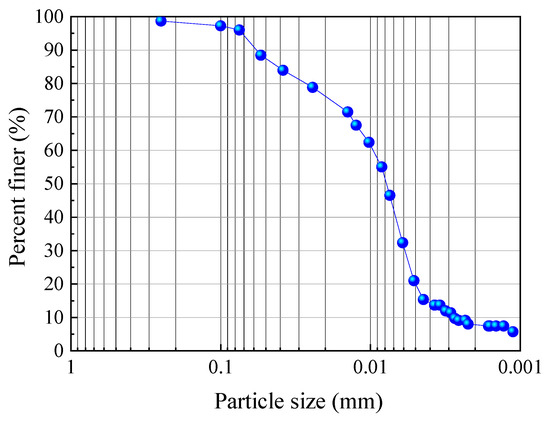
Figure 1.
Particle distribution curve of dredged sediment.
The cementitious stabilizer selected for this study was Ordinary Portland Cement (OPC) PO42.5 manufactured under GB 175-2007 specifications [55] by Jianing Cement Co. Ltd., Yancheng, China. Standardized testing indicated a 28-day compressive strength of 50.3 MPa and a splitting tensile strength of 9.2 MPa. Consistency measurements via the Vicat apparatus recorded initial and final setting times of 157 ± 5 and 236 ± 8 min, respectively [53]. The oxide composition quantified through X-ray fluorescence (XRF) is tabulated in Table 2, showing predominant concentrations of CaO (59.8%), SiO2 (24.6%), and Al2O3 (5.2%).

Table 2.
Cement chemical composition.
2.2. Specimen Preparation and Test Program
Cement-stabilized specimens were prepared with three target water contents (1.5LL = 78%, 2LL = 104%, 2.5LL = 130%) and cement dosages ranging from 50 to 200 kg/m3 based on wet soil volume. The specimens were mechanically mixed (120 rpm, 15 min) and compacted in three layers using a vibration compaction method, yielding cubes measuring 70.7 × 70.7 × 70.7 mm. Curing was conducted under controlled conditions (20 ± 2 °C, RH ≥ 95%) and divided into two scenarios: curing without and with applied pressure. The applied pressure was adjusted according to the curing age of the specimens subjected to the pressure. During the initial period (first 7 days), no pressure was applied, because the strength of the specimens was relatively weak and unable to withstand external stress. From the 7th to the 14th day, a pressure of 200 kPa was applied, and from the 14th to the 28th day, the pressure was increased to 400 kPa [56]. The pressure values for these two stages (200 kPa and 400 kPa) were determined based on the minimum value of 80% of the yield stress of specimens with varying water and cement contents after 7 and 14 days of curing, under conditions with no additional curing stress applied [56]. The curing pressure applied in this study is relatively low, and thus it should not be expected to significantly influence the formation of crystalline phases typically associated with higher pressures, such as 11 Å/14 Å tobermorite, awillite, or ordered C-S-H types (e.g., Types I and II). UCS tests were conducted at a 1 mm/min displacement rate following GB/T 50123-2019 [57], with experimental variables detailed in Table 3. Each specimen underwent duplicate testing, and the error between the duplicate test results was maintained within 5%, ensuring consistency and reliability in the experimental data. Figure 2 illustrates the comprehensive testing program, including UCS testing and scanning electron microscopy (SEM) microstructural analysis.

Table 3.
Experimental parameters matrix under varied curing conditions.
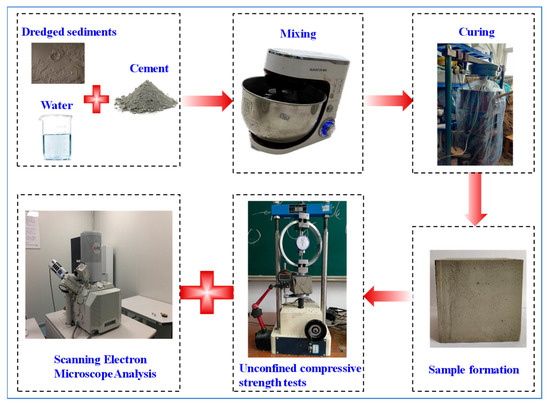
Figure 2.
Comprehensive flowchart of specimen preparation and testing.
3. Results and Discussion
3.1. Stress–Strain Behavior
Figure 3 reveals the axial stress–strain characteristics of cement-stabilized dredged sediments under varying curing pressures, cement dosages, initial moisture contents, and curing ages. All curves exhibited typical four-stage strain-softening behavior: (1) the elastic stage, where stress and strain showed linear proportionality; (2) the plastic hardening stage, characterized by a nonlinear stress increase until peak stress was reached (occurring at axial strains of 2–4%); (3) the failure stage, marked by rapid post-peak stress attenuation due to shear-induced crack propagation; and (4) the residual stage, during which stress decay stabilized with minimal reduction. Experimental data demonstrated the decisive influence of initial moisture content: specimens with high moisture content (w = 104%) consistently exhibited lower stress–strain curves and residual stresses compared to those with low moisture content (w = 78%), confirming the detrimental role of excess moisture in weakening cementitious bonding.
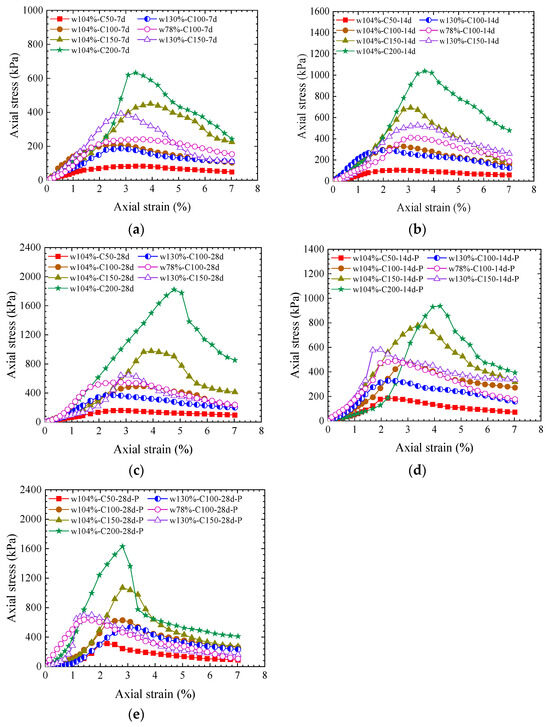
Figure 3.
Stress–strain behaviors of specimens across various curing durations: (a) 7 days, (b) 14 days, (c) 28 days without curing pressure, and (d) 14 days and (e) 28 days with curing pressure.
Cement dosage critically modulated mechanical behavior. Under constant moisture content and curing age, higher cement dosages elevated stress–strain curves and enhanced peak stresses. Cement dosage also governed failure modes. Specimens with cement dosages greater than 150 kg/m3 exhibited pronounced brittle failure, characterized by a rapid post-peak stress drop, whereas specimens with low dosages (≤100 kg/m3) displayed ductile behavior akin to remolded soil. This divergence arose from differences in cementation levels: high-dosage specimens formed continuous rigid frameworks due to sufficient hydration products. In contrast, insufficient hydration in low-dosage specimens preserved soil-like plasticity.
Figure 4 compares the influence of curing pressure on the stress–strain responses of pressurized and non-pressurized specimens. Pressurized specimens exhibited marked embrittlement: leftward shifts in the stress–strain curves, accelerated post-peak stress decay, and reduced failure strains—particularly at 28 days. Meanwhile, regardless of the curing age (14 days or 28 days), the stress–strain curves of pressurized specimens consistently remained above those of non-pressurized specimens, indicating a generally positive impact of curing pressure on mechanical performance. However, the extent and nature of this impact varied with cement dosage and moisture content.
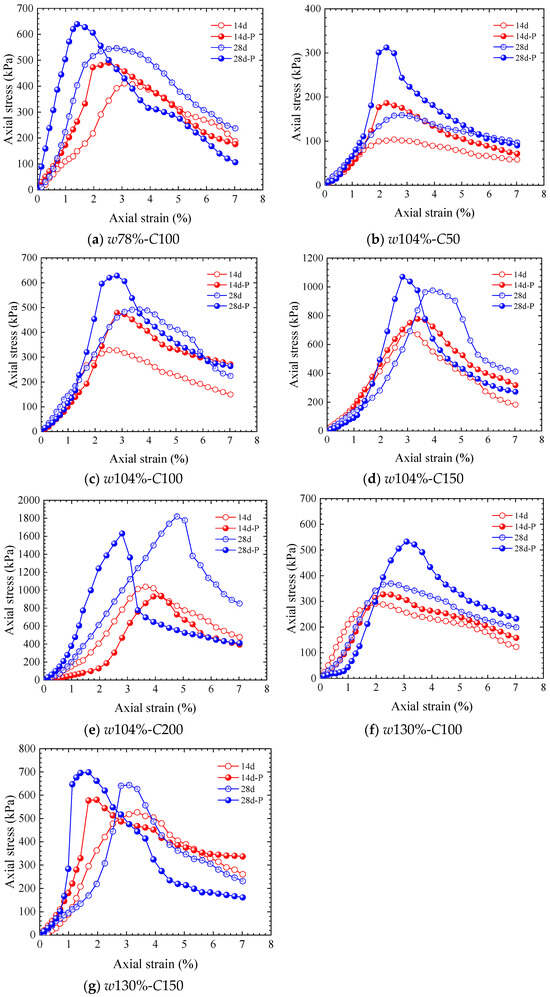
Figure 4.
Effects of curing pressure on the stress–strain relationship of specimens.
For the w = 78% case (Figure 4a), the pressurized curves remained above their non-pressurized counterparts, with the plastic-stage stiffness ordered as 28d-P > 28d > 14d-P > 14d. P represented the specimens subjected to curing pressure. Curing pressure enhanced the specimen’s stiffness. At w = 104.0% (Figure 4b–e), the effects of curing pressure were more nuanced. Pressurized specimens with cement dosages of ≤150 kg/m3 showed strength gains compared to non-pressurized specimens, reflecting the positive influence of curing pressure on strengthening. However, specimens with C = 200 kg/m3 exhibited anomalous strength reduction (Figure 4e). This reversal was attributed to synergistic effects: high cement content intensified brittleness, and curing-pressure-induced pre-stress triggered abrupt failure at critical loads, resulting in strength deterioration.
In summary, while curing pressure generally improved the mechanical performance of specimens, its effects were contingent on cement dosage and moisture content. The interplay between these factors led to variations in strength, stiffness, and failure behavior, underscoring the complex nature of the material’s response to curing pressure.
3.2. Evolution Characteristics of Secant Modulus
The secant modulus E50, a vital factor for evaluating the deformation behavior of cement-stabilized soils, refers to the slope of the stress–strain curve when the stress reaches 50% of the maximum axial stress [44]. This parameter exhibits a significant positive correlation with the unconfined compressive strength qu, expressed mathematically as E50 = k·qu [58]. Figure 5 illustrates the quantitative relationship between E50 and qu for cement-stabilized specimens under different curing pressure conditions. The results demonstrated that E50 increased approximately linearly with qu, regardless of curing pressure. Specifically, E50 ranged from 19qu to 75qu for specimens without curing pressure, with a mean fitting coefficient k of 24. In contrast, specimens subjected to curing pressure exhibited an expanded E50 range of 18qu to 86qu, accompanied by an elevated mean k-value of 34. These findings quantitatively confirmed that curing pressure enhanced the secant modulus coefficient k by 41.7%, significantly improving the stiffness characteristics of cement-stabilized specimens.
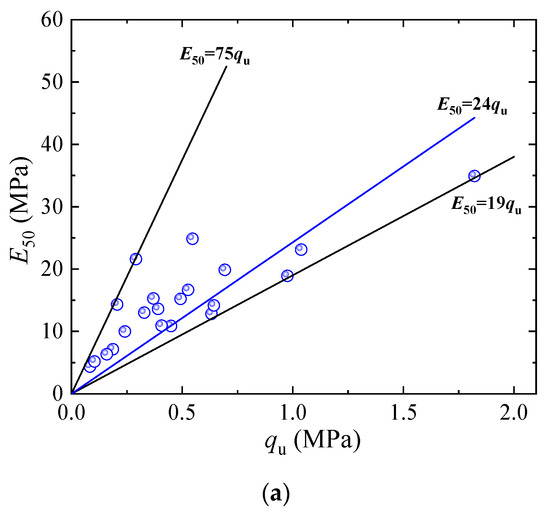
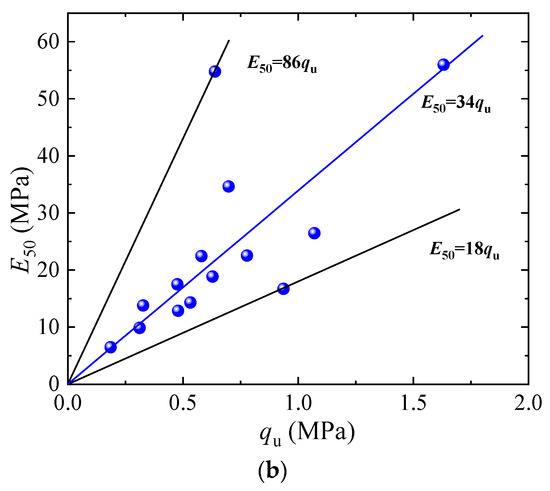
Figure 5.
E50 variation with qu (a) without curing pressure and (b) with curing pressure.
3.3. Unconfined Compressive Strength
Figure 6 depicts the correlation between unconfined compressive strength and initial water content in cement-stabilized dredged sediments, particularly for a 100 kg/m3 cement content across various curing durations. The data revealed that strength decreased as water content increased. For example, increasing the initial water content from 78% to 130% in pressurized specimens resulted in a notable 32.4% reduction in strength over 28 days. This significant reduction in strength decreased from an initial value of 546.68 kPa to a final value of 369.67 kPa. The degradation of strength could be attributed to two primary mechanisms: (1) pore water saturation at higher water content levels, spanning from 1.5 to 2.5 times the liquid limit, which led to a reduction in interparticle bonding forces, and (2) the presence of excessive water, which diluted the cement hydration products, thereby negatively impacting the formation of critical cementitious phases such as calcium silicate hydrate (C-S-H) networks. Additionally, applying curing pressure was found to enhance the strength of the specimens significantly. For instance, this improvement was exemplified by a remarkable 45.8% increase in strength, rising from an initial value of 328.81 kPa to a final value of 479.55 kPa, for 14-day specimens with a water content of 104%.
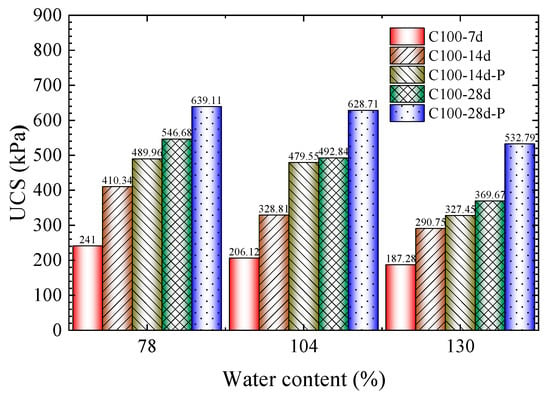
Figure 6.
Variation in UCS with water content in specimens.
As shown in Figure 7, a shift in cement content from 50 kg/m3 to 200 kg/m3 yielded a marked improvement in strength development at all curing stages. In non-pressurized specimens, the strength exhibited a substantial increase, with a 7.59-fold enhancement at 7 days (rising from 83.29 kPa to 632.45 kPa) and an even more pronounced 11.43-fold increase at 28 days (climbing from 159.39 kPa to 1821.75 kPa). These remarkable improvements were primarily driven by the age-dependent progression of cement hydration kinetics, where extended curing durations allowed for greater microstructural stabilization, including the precipitation of calcium silicate hydrate (C-S-H), a key cementitious phase. This stabilization process formed a denser and stronger material matrix over time.
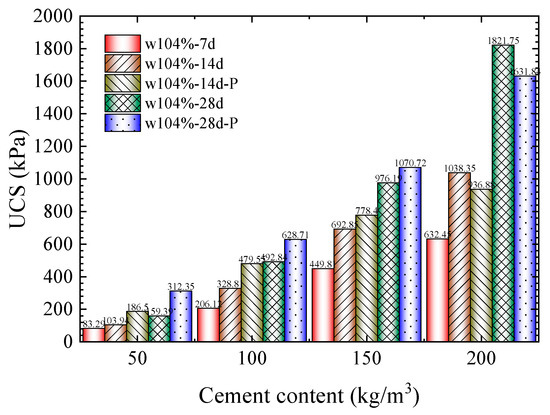
Figure 7.
Variation in UCS with cement content in specimens.
In contrast, pressure-cured specimens exhibited a different trend in strength development. While they initially showed significant gains, the efficiency of these improvements decreased with prolonged aging. For example, 150 kg/m3 specimens demonstrated a 12.35% increase in strength at 14 days (rising from 692.85 kPa to 778.4 kPa), but this improvement reduced to 9.7% at 28 days (increasing from 976.0 kPa to 1070.72 kPa). This pattern suggested that under curing pressure conditions, the early stages of hydration were preferentially accelerated, leading to rapid strength gains in the short term.
3.4. Predictive Model for Unconfined Compressive Strength
Experimental analysis revealed that the unconfined compressive strength (qu) of cement-stabilized dredged sediments was governed by four key parameters: cement dosage (C), initial water content (w), curing age (T), and curing pressure (P). To establish a practical predictive framework, this study built upon the empirical model proposed by [4] for 28-day cured specimens, which related strength to cement content and porosity:
Gs represents the specific gravity of soil particles, e denotes the void ratio (derived as e = Gs w under saturated conditions), and C0 signifies the threshold cement content required for strength development. For non-pressurized specimens, calibration against experimental data yielded age-dependent parameters:
At 7 days: K = 60.02 kN/kg·m, C0 = 40.08 kg/m3;
At 14 days: K = 95.36 kN/kg·m, C0 = 43.15 kg/m3;
At 28 days: K = 134.11 kN/kg·m, C0 = 44.97 kg/m3.
The critical cement content C0 exhibited minimal variation across curing ages, with a mean value of 42.74 kg/m3. Meanwhile, the strength coefficient K demonstrated a linear relationship with curing age: K = 3.42T + 40.65 (R2 > 0.98). Substituting these coefficients into Equation (1) produced the age-incorporated strength prediction model for non-pressurized specimens:
Figure 8 presents a comparative analysis between experimentally measured unconfined compressive strength values and theoretical predictions for non-pressurized specimens. The results demonstrated a high level of agreement, with the coefficient of determination (R2) reaching 0.92, indicating the strong predictive capability of the constitutive model.
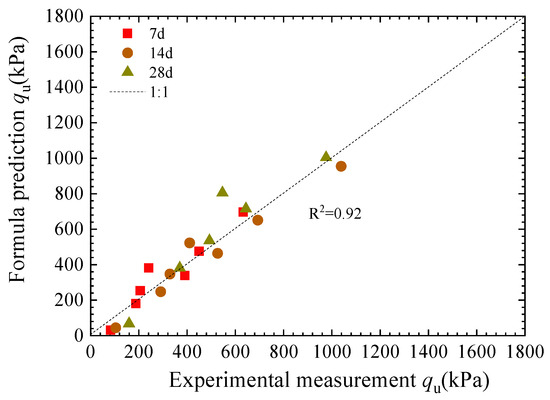
Figure 8.
A comparison between the measured UCS and the calculated value of the formula for non-pressurized specimens.
For pressurized curing conditions (200 kPa for 7–14 days; 400 kPa for 14–28 days), an additional pressure-dependent term was introduced to account for dual effects: (1) enhanced early-age hydration through pore compression and (2) induced brittleness at high cement contents (C ≥ 150 kg/m3). The refined model became
The denominator (5.2 − 0.02C) quantifies the cement-content-dependent pressure sensitivity, reflecting reduced strength gains under combined high-pressure and high-cement conditions.
As illustrated in Figure 9, the model demonstrated strong predictive capability across all test conditions, with calculated versus measured qu values yielding a correlation coefficient of R2 = 0.91. This robust agreement validated the model’s capacity to guide engineering designs by quantifying synergistic interactions among cementation, curing duration, and pressure effects.
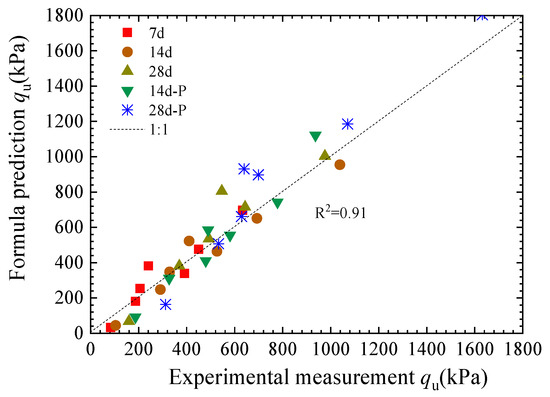
Figure 9.
Comparative analysis between experimentally measured UCS values and theoretical predictions for pressurized specimens.
The residual analysis was conducted as shown in Figure 10. The residual-fitted plot (Figure 10a) reveals that the residuals are randomly distributed around the zero axis, exhibiting no funnel-shaped or curvilinear trends. This observation supports the validity of the linear assumption underlying the proposed model. Notably, outliers, marked with red hollow circles, are primarily associated with high cement content (C = 200 kPa) and early brittle deterioration induced by high curing pressure, as detailed in Section 3.1. The quantile–quantile plot (Figure 10b) demonstrates that the points are generally aligned along the diagonal line, with slight deviations only at the tails, indicating that the residuals approximate a normal distribution. The model’s coefficient of determination, R2, is 0.91, and the residual behavior adheres to regression assumptions, affirming our predictions’ overall reliability.
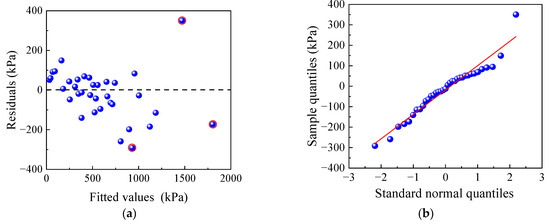
Figure 10.
Residual analysis: (a) residuals versus fitted values; (b) quantile–quantile (Q-Q) plot.
3.5. Microstructural Analysis
Scanning electron microscopy (SEM) was utilized to investigate the influence of curing pressure on the microstructure of stabilized sediment in greater detail. As a high-resolution microscopic imaging technique, SEM allows for direct visualization of soil particle arrangements, pore distributions, and hydration product morphologies, providing reliable microscopic evidence to elucidate the mechanisms behind curing pressure.
Figure 11 presents SEM micrographs (at 20,000× magnification) and corresponding binary images of cement-stabilized soil samples under non-pressurized and pressurized conditions (C = 100 kg/m3, ratio w = 130%) at curing ages of 14 and 28 days. Curing pressure induced significant microstructural changes in the cement-stabilized soil under both curing ages of 14 and 28 days. Non-pressurized specimens exhibited loose particle arrangements with disordered orientations (Figure 11a,c), where hydration products were sparsely distributed along particle surfaces and within macropores, resulting in weak interfacial bonding. In contrast, pressurized specimens demonstrated compacted particle configurations (Figure 11b,d) with reduced interparticle distances, promoting enhanced contact areas and facilitating hydration product infiltration.
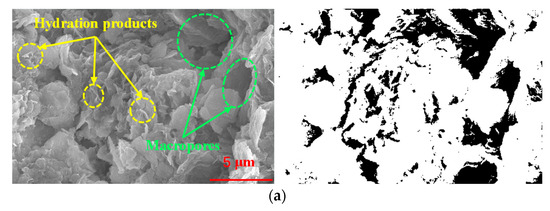
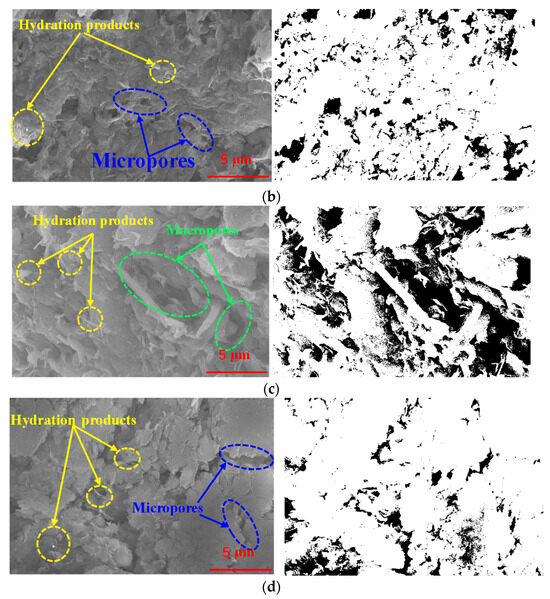
Figure 11.
SEM images of the microstructure and corresponding binary images of the sample magnified 20,000× (100 kg/m3 cement, 130% water content): (a) T = 14 days, unpressurized; (b) T = 14 days, pressurized; (c) T = 28 days, unpressurized; (d) T = 28 days, pressurized.
The pore structure transitioned from irregular macropores in non-pressurized specimens to uniformly refined micropores under pressure, significantly improving spatial homogeneity. Concurrently, hydration products underwent redistribution and densification—under pressure, these products were compressed into pore spaces and extruded onto particle surfaces, forming continuous cementation bridges [53,56]. This microstructural reorganization enhanced mechanical performance through dual mechanisms: chemically, the strengthened connectivity of hydration products increased cohesive bonding; mechanically, pressure-induced particle reorientation created interlocking architectures that restricted particle displacement [46,48,59].
The total porosity and maximum equivalent pore diameter in the microstructure’s binary images can be calculated through image processing technology, as summarized in Table 4. It is evident that at a curing time of 14 days, the total porosity of the non-pressurized specimens was 21.45%, while that of the pressurized specimens was 7.38%, a reduction of 65.59%. The maximum equivalent pore diameter of the non-pressurized specimens was 5.29 μm, compared to 2.11 μm for the pressurized specimens, a decrease of 60.11%. For the curing time of 28 days, the total porosity of the non-pressurized specimens was 15.15%, and that of the pressurized specimens was 7.31%, a reduction of 51.75%. The maximum equivalent pore diameter of the non-pressurized specimens was 7.71 μm, compared to 4.58 μm for the pressurized specimens, a decrease of 40.60%. As the curing time increased, the increase in hydration products led to a corresponding reduction in total porosity. Pressurized curing effectively reduced the total porosity and the maximum equivalent pore diameter. However, it is noteworthy that the effect of 28-day pressurized curing on reducing total porosity and maximum equivalent pore diameter was less pronounced than that of 14-day pressurized curing. The reason may be that the initial application of curing pressure at 14 days significantly promoted a reduction in porosity. By the time further curing pressure was applied at 28 days, the specimens had already developed a stronger structure, and the impact of the curing pressure had diminished. Nonetheless, it still affected the reduction in the number and size of pores.

Table 4.
Total porosity and maximum equivalent pore diameter in binary images.
The synergistic effects of chemical bonding enhancement and mechanical interlocking collectively contributed to macro-property improvements, such as compressive resistance. SEM evidence conclusively links curing pressure to optimized particle-pore-hydrate configurations, establishing a microstructure–property correlation critical for engineered soil stabilization.
4. Conclusions
This study examined the influence of curing pressure on the unconfined compressive strength of cement-stabilized dredged sediments through controlled laboratory tests and analytical modeling. A multi-factor coupled strength prediction model was established, and the evolution law of the microstructure was elucidated. The main conclusions were as follows:
- (1)
- Curing pressure significantly impacted the stabilized sediments’ failure mode and load-carrying capacity. Upon application of pressure, the specimens demonstrated higher peak stress and exhibited more pronounced brittle failure characteristics. Moreover, the failure strain of the pressurized samples was generally lower than that of the unpressurized ones.
- (2)
- The secant modulus analysis indicated a significant linear relationship between specimen stiffness and unconfined compressive strength, with curing pressure enhancing the proportional coefficient by 41.7%.
- (3)
- Based on experimental data, the strength prediction formula innovatively introduced a correction term for curing pressure, achieving a collaborative characterization of water content, cement dosage, curing age, and pressure. Under high cement dosage, the brittle deterioration caused by pressure could be effectively quantified through the correction term, with prediction errors controlled within a reasonable range.
- (4)
- Microstructural analysis confirmed that curing pressure optimized material performance through dual mechanisms: physical compaction enhanced particle rearrangement and compaction, significantly reducing porosity and optimizing pore size distribution; chemical activation strengthened the bonding network of hydration products, transforming it from a discrete to a continuous network structure.
One limitation of this study is the insufficient planning of microscopic testing, which could be addressed in future work by incorporating techniques such as XRF, XRD, or EDS analysis. This study has shown that curing pressure differently affects cement-solidified dredged sediments at various water contents and cement dosages. A preliminary fitting formula has been proposed based on the findings. Future research will explore a wider range of curing pressures and their application times to understand their impact on sediment stabilization.
Author Contributions
Conceptualization, C.Q.; Methodology, X.L. and G.X.; Investigation, Y.L. and X.L.; Data curation, Y.L. and D.Z.; Writing—original draft, C.Q.; Writing—review & editing, G.X.; Funding acquisition, C.Q. All authors have read and agreed to the published version of the manuscript.
Funding
This research is funded by the Joint Project of Industry-University-Research of Jiangsu Province (Grant No. BY20221035) and receives additional support from the Qinglan Project of Jiangsu Province of China.
Data Availability Statement
Data are contained within the article.
Conflicts of Interest
Author Xingbing Li was employed by the company Jiangsu Province Engineering Investigation and Research Institute Co., Ltd. The remaining authors declare that the research was conducted in the absence of any commercial or financial relationships that could be construed as a potential conflict of interest.
References
- Schlue, B.F.; Moerz, T.; Kreiter, S. Influence of shear rate on undrained vane shear strength of organic harbor mud. J. Geotech. Geoenvironmental Eng. 2010, 136, 1437–1447. [Google Scholar] [CrossRef]
- Tang, C.S.; Cheng, Q.; Wang, P.; Wang, H.S.; Wang, Y.; Inyang, H.I. Hydro-mechanical behavior of fiber reinforced dredged sludge. Eng. Geol. 2020, 276, 105779. [Google Scholar] [CrossRef]
- Bian, X.; Zhao, F.Y.; Zeng, L.L.; Ren, Z.L.; Li, X.Z. Role of superabsorbent polymer in compression behavior of high water content slurries. Acta Geotech. 2024, 19, 6163–6178. [Google Scholar] [CrossRef]
- Tsuchida, T.; Tang, Y.X. Estimation of compressive strength of cement-treated marine clays with different initial water contents. Soils Found. 2015, 55, 359–374. [Google Scholar] [CrossRef]
- Huang, Y.H.; Dong, C.; Zhang, C.L.; Xu, K. A dredged material solidification treatment for fill soils in East China: A case history. Mar. Georesources Geotechnol. 2017, 35, 865–872. [Google Scholar] [CrossRef]
- Ding, J.W.; Feng, X.S.; Xu, G.Z.; Qian, S.; Ji, F. Strength properties and microstructural characteristics of stabilized dredged materials at high water contents. J. Test. Eval. 2019, 47, 2225–2239. [Google Scholar] [CrossRef]
- Geng, W.J.; Yin, J.; Bian, Z.J.; Liu, L.; Xu, G.Z. Fiber Efficiency on the flow behaviors and compressibility-permeability of fiber-reinforced cemented waste slurry. J. Mater. Civ. Eng. 2022, 34, 04022347. [Google Scholar] [CrossRef]
- Wang, Q.; Yang, C.L.; Guo, J.W.; Chu, Z.Y.; Li, Y.F. Mechanical properties and microscopic mechanism of dredged silt solidification by slag-chlorine oxygen magnesium cement. Constr. Build. Mater. 2024, 448, 138211. [Google Scholar] [CrossRef]
- Bian, X.; Peng, W.H.; Qiu, C.C.; Xu, G.Z.; Yao, Y.K. Model test on bearing capacity of cemented slurry reinforced pile composite foundation. Case Stud. Constr. Mater. 2023, 19, e02482. [Google Scholar] [CrossRef]
- Geng, W.J.; Xu, G.Z. Assessment of strength and dewatering efficiency in straw-reinforced dredged slurry. Constr. Build. Mater. 2025, 463, 140005. [Google Scholar] [CrossRef]
- Hossain, M.U.; Wang, L.; Chen, L.; Tsang, D.C.W.; Ng, S.T.; Poon, C.S.; Mechtcherine, V. Evaluating the environmental impacts of stabilization and solidification technologies for managing hazardous wastes through life cycle assessment: A case study of Hong Kong. Environ. Int. 2020, 145, 106139. [Google Scholar] [CrossRef]
- Lang, L.; Xue, D.X.; Dong, M.; Zhang, W.; Li, J.S. Strength development of dredged sediment stabilized with nano-modified sulphoaluminate cement. Soils Found. 2025, 65, 101558. [Google Scholar] [CrossRef]
- Liu, L.; Zhang, B.H.; Li, Y.C.; Sun, H.J.; Chen, Y.G.; Deng, Y.F. Parametric optimization of Cement-based solidification combined with vacuum-assisted filtration. Transp. Geotech. 2024, 48, 101351. [Google Scholar] [CrossRef]
- Weggel, J.R.; Dortch, J.; Merida, V.Z. Experiments with water and slurries in hanging geotextile bags: A further appraisal. Geotext. Geomembr. 2011, 29, 502–513. [Google Scholar] [CrossRef]
- Yin, J.; Han, W.X.; Xu, G.Z.; Hu, M.M.; Miao, Y.H. Effect of salinity on strength behavior of cement-treated dredged clay at high initial water contents. KSCE J. Civ. Eng. 2019, 23, 4288–4296. [Google Scholar] [CrossRef]
- Shi, L.; Yin, X.; Sun, H.L.; Pan, X.D.; Yuan, Z.H.; Cai, Y.Q. A new approach for determining compressibility and permeability characteristics of dredged slurries with high water content. Can. Geotech. J. 2022, 59, 965–977. [Google Scholar] [CrossRef]
- Wu, Y.J.; Wang, X.D.; Zhang, X.D.; Lu, Y.T.; Xu, Y.; Tran, Q.C.; Vu, Q.V. Experimental study on the treatment of sludge discharged from an soil washing plant by vacuum preloading. Environ. Eng. Sci. 2021, 38, 899–909. [Google Scholar] [CrossRef]
- Pu, H.; Khoteja, D.; Zhou, Y.; Pan, Y. Dewatering of dredged slurry by horizontal drain assisted with vacuum and flocculation. Geosynth. Int. 2022, 29, 299–311. [Google Scholar] [CrossRef]
- Cai, Y.Q.; Qiao, H.H.; Wang, J.; Geng, X.Y.; Wang, P.; Cai, Y. Experimental tests on effect of deformed prefabricated vertical drains in dredged soil on consolidation via vacuum preloading. Eng. Geol. 2017, 222, 10–19. [Google Scholar] [CrossRef]
- Liu, F.Y.; Tao, Y.; Ni, J.F.; Gao, Z.Y.; Yuan, G.H. Slurry improvement by vacuum preloading in combination with electro-osmosis and with dynamic compaction method. Mar. Georesources Geotechnol. 2021, 39, 709–718. [Google Scholar] [CrossRef]
- Xu, G.Z.; Han, Q.Y.; Wang, Z.H.; Wu, J.X.; Yin, J. Eco-friendly rice straw as vertical drains for dredged slurry treatment as construction fill. Constr. Build. Mater. 2022, 345, 128244. [Google Scholar] [CrossRef]
- Xu, G.Z.; Zhang, Q.Y.; Gao, M.Y.; Ni, J.J.; Weng, J.X. Influence of layered degradable straw drainage system on eco-treatment of dredged sludge under vacuum preloading. Mar. Georesources Geotechnol. 2024, 42, 1687–1698. [Google Scholar] [CrossRef]
- Ni, J.; Liu, S.; Wang, Y.; Xu, G. Synergistic influence of lime and straw on dredged sludge reinforcement under vacuum preloading. Constr. Build. Mater. 2024, 421, 135642. [Google Scholar] [CrossRef]
- Xiong, X.; Chen, H.; Jiang, P.C.; Li, W.J.; Yuan, L.H.; Lin, X.Y.; Yang, X.; Cai, L.Y.; Cheng, G.H.; Wu, Z. Honeycombed pomegranate-like sludge ceramsite particles: Preparation with fly ash floating beads as the pore-forming template and performance optimization. Constr. Build. Mater. 2024, 453, 139017. [Google Scholar] [CrossRef]
- Dang, J.T.; Hao, L.K.; Wang, T.Y.; Xiao, J.Z.; Zhao, H. Improving thermal conductivity and drying shrinkage of foamed concrete with artificial ceramsite from excavation soil and sewage sludge. Constr. Build. Mater. 2024, 438, 137010. [Google Scholar] [CrossRef]
- Detho, A.; Kadir, A.A. Evaluating technical properties of fired clay brick production with mosaic sludge: A comprehensive study on heavy metal leachability for sustainable environmental and economic benefits. J. Build. Eng. 2024, 94, 110072. [Google Scholar] [CrossRef]
- Nguyen, H.N.; Dang, H.T.T.; Pham, L.T.N.; Nguyen, H.X.; Tong, K.T.; Pham, T.T.; Nguyen, K.M.; Tran, H.T.M. Effective sludge management: Reuse of biowaste and sewer sediments for fired bricks. J. Air Waste Manag. Assoc. 2024, 74, 478–489. [Google Scholar] [CrossRef]
- Lecomte, T.; Baraud, F.; Poree, S.; Leleyter, L. Environmental availability of some trace metals in dredged sediments disposed on-land before use in fired brick processing. Int. J. Environ. Sci. Technol. 2025, 22, 679–692. [Google Scholar] [CrossRef]
- Du, Y.J.; Wei, M.L.; Jin, F.; Liu, Z.B. Stress-strain relation and strength characteristics of cement treated zinc-contaminated clay. Eng. Geol. 2013, 167, 20–26. [Google Scholar] [CrossRef]
- Kang, G.; Tsuchida, T.; Athapaththu, A.M.R.G. Strength mobilization of cement-treated dredged clay during the early stages of curing. Soils Found. 2015, 55, 375–392. [Google Scholar] [CrossRef]
- Ghadakpour, M.; Choobbasti, A.J.; Kutanaei, S.S. Experimental study of impact of cement treatment on the shear behavior of loess and clay. Arab. J. Geosci. 2020, 13, 184. [Google Scholar] [CrossRef]
- Yin, J.; Wang, Q.Y.; Ding, J.W.; Xu, G.Z.; Hu, G.H. Time-dependent strength behavior of dredged clays at low effective stresses. Mar. Georesources Geotechnol. 2022, 40, 1255–1264. [Google Scholar] [CrossRef]
- Wang, Y.; Wang, C.J.; Hu, Z.H.; Sun, R. Experimental study on the strength deterioration and mechanism of stabilized river silt reinforced with cement and alginate fibers. Materials 2024, 17, 3124. [Google Scholar] [CrossRef] [PubMed]
- Song, S.X.; Lv, C.; Du, J.; Wang, J.J. Correlation analysis between fracture toughness and tensile strength of cement soil based on notched semi-circle bend specimen. J. Adhes. Sci. Technol. 2024, 38, 3047–3062. [Google Scholar] [CrossRef]
- Jaditager, M.; Sivakugan, N. Consolidation behavior of fly ash-based geopolymer-stabilized dredged mud. J. Waterw. Port Coast. Ocean Eng. 2018, 144, 06018003. [Google Scholar] [CrossRef]
- Wang, D.X.; Zhu, J.Y.; Zeng, G. Comprehensive evaluation on magnesium potassium phosphate cement-mineral additive stabilized waste sludge. Mar. Georesources Geotechnol. 2024, 42, 1–13. [Google Scholar] [CrossRef]
- Zeng, L.L.; Bian, X.; Weng, J.X.; Zhang, T. Wetting-drying effect on the strength and microstructure of cement-phosphogypsum stabilized soils. J. Rock Mech. Geotech. 2024, 16, 1049–1058. [Google Scholar] [CrossRef]
- Yu, H.; Joshi, P.; Lau, C.; Ng, K. Coal-derived char for durability improvement of cement stabilized soil under freeze-thaw, wet-dry, and sulfate attack. Can. Geotech. J. 2025, 62, 1–20. [Google Scholar] [CrossRef]
- Sahlabadi, S.H.; Bayat, M.; Mousivand, M.; Saadat, M. Freeze-thaw durability of cement-stabilized soil reinforced with polypropylene/basalt fibers. J. Mater. Civ. Eng. 2021, 33, 04021232. [Google Scholar] [CrossRef]
- Zhao, J.L.; Yang, P.; Li, L.; Zhang, T.; Wang, H.B. Influence of freeze thaw on stress-strain characteristics and microstructure of cement and fly ash stabilized organic soil. Geomech. Eng. 2024, 39, 529–546. [Google Scholar] [CrossRef]
- Bayesteh, H.; Hezareh, H. Behavior of cement-stabilized marine clay and pure clay minerals exposed to high salinity grout. Constr. Build. Mater. 2023, 383, 131334. [Google Scholar] [CrossRef]
- Zhang, H.G.; Liu, T.; Cui, Y.X.; Wang, W.H.; Qing, C.R. Experimental study on the performance of basalt fiber combined with cement-based material solidified shield waste mud under the coupled effects of acid corrosion and dry-wet cycles. Constr. Build. Mater. 2025, 463, 140110. [Google Scholar] [CrossRef]
- He, J.; Shi, X.K.; Li, Z.X.; Zhang, L.; Feng, X.Y.; Zhou, L.R. Strength properties of dredged soil at high water content treated with soda residue, carbide slag, and ground granulated blast furnace slag. Constr. Build. Mater. 2020, 242, 118126. [Google Scholar] [CrossRef]
- Bian, X.; Zeng, L.L.; Ji, F.; Xie, M.; Hong, Z.S. Plasticity role in strength behavior of cement-phosphogypsum stabilized soils. J. Rock Mech. Geotech. 2022, 14, 1977–1988. [Google Scholar] [CrossRef]
- Ding, J.W.; Wan, X.; Jiao, N.; Zhang, S.; Chen, W.H. Collaborative effects of red mud and phosphogypsum on geotechnical behavior of cement-stabilized dredged clay. Bull. Eng. Geol. Environ. 2024, 83, 200. [Google Scholar] [CrossRef]
- Zhang, R.J.; Zheng, J.J.; Bian, X.Y. Experimental investigation on effect of curing stress on the strength of cement-stabilized clay at high water content. Acta Geotech. 2017, 12, 921–936. [Google Scholar] [CrossRef]
- Liu, C.Y.; Starcher, R.D. Effects of curing conditions on unconfined compressive strength of cement- and cement-fiber-improved soft soils. J. Mater. Civ. Eng. 2013, 25, 1134–1141. [Google Scholar] [CrossRef]
- He, X.X.; Chen, Y.J.; Wan, Y.; Liu, L.; Xue, Q. Effect of curing stress on compression behavior of cement-treated dredged sediment. Int. J. Geomech. 2020, 20, 04020204. [Google Scholar] [CrossRef]
- Yaghoubi, M.; Arulrajah, A.; Disfani, M.M.; Horpibulsuk, S.; Leong, M. Compressibility and strength development of geopolymer stabilized columns cured under stress. Soils Found. 2020, 60, 1241–1250. [Google Scholar] [CrossRef]
- Shibi, T.; Ohtsuka, Y. Influence of applying overburden stress during curing on the unconfined compressive strength of cement-stabilized clay. Soils Found. 2021, 61, 1123–1131. [Google Scholar] [CrossRef]
- He, X.X.; Chen, Y.J.; Li, Y.; Guo, D.D.; Xue, Q.; Wang, S.Q.; Wang, P.; Wan, Y.; Liu, L. Consolidation behavior and microstructure properties of cement-treated dredged soil during the stress curing. Mar. Georesources Geotechnol. 2022, 40, 500–510. [Google Scholar] [CrossRef]
- ASTM D421-85; Standard Practice for Dry Preparation of Soil Samples for Particle-Size Analysis and Determination of Soil Constants. ASTM International: West Conshohocken, PA, USA, 2007.
- Qiu, C.C.; Xu, L.W.; Xu, G.Z.; Zhang, D.; Yao, D. Influence of curing stress on the uniaxial compressive properties of cement-solidified dredged mud columns. Mar. Georesources Geotechnol. 2024, 43, 679–693. [Google Scholar] [CrossRef]
- ASTM D422-63; Standard Test Method for Particle-Size Analysis of Soils. ASTM International: West Conshohocken, PA, USA, 2007.
- GB 175-2007; Common Portland Cement. General Administration of Quality Supervision, Inspection and Quarantine: Beijing, China, 1999.
- Qiu, C.C.; Xu, G.Z.; Zhang, D.; Wu, F.H.; Cao, D.H. Effect of curing stress on the interface property of cement-treated dredged mud and geogrid. Mar. Georesources Geotechnol. 2025, 43, 203–217. [Google Scholar] [CrossRef]
- GB/T 50123-2019; Standard for Geotechnical Testing Method. Ministry of Construction: Beijing, China, 2019.
- Kang, G.; Tsuchida, T.; Kim, Y. Strength and stiffness of cement-treated marine dredged clay at various curing stages. Constr. Build. Mater. 2017, 132, 71–84. [Google Scholar] [CrossRef]
- Zhang, J.; Zhang, W.B.; Wang, Z.B.; Ge, D.X.; Xu, G.Z.; Yin, J. Influence of curing stress on compression characteristic of cement-treated dredged slurry at high water contents. Mar. Georesources Geotechnol. 2024, 42, 305–316. [Google Scholar] [CrossRef]
Disclaimer/Publisher’s Note: The statements, opinions and data contained in all publications are solely those of the individual author(s) and contributor(s) and not of MDPI and/or the editor(s). MDPI and/or the editor(s) disclaim responsibility for any injury to people or property resulting from any ideas, methods, instructions or products referred to in the content. |
© 2025 by the authors. Licensee MDPI, Basel, Switzerland. This article is an open access article distributed under the terms and conditions of the Creative Commons Attribution (CC BY) license (https://creativecommons.org/licenses/by/4.0/).